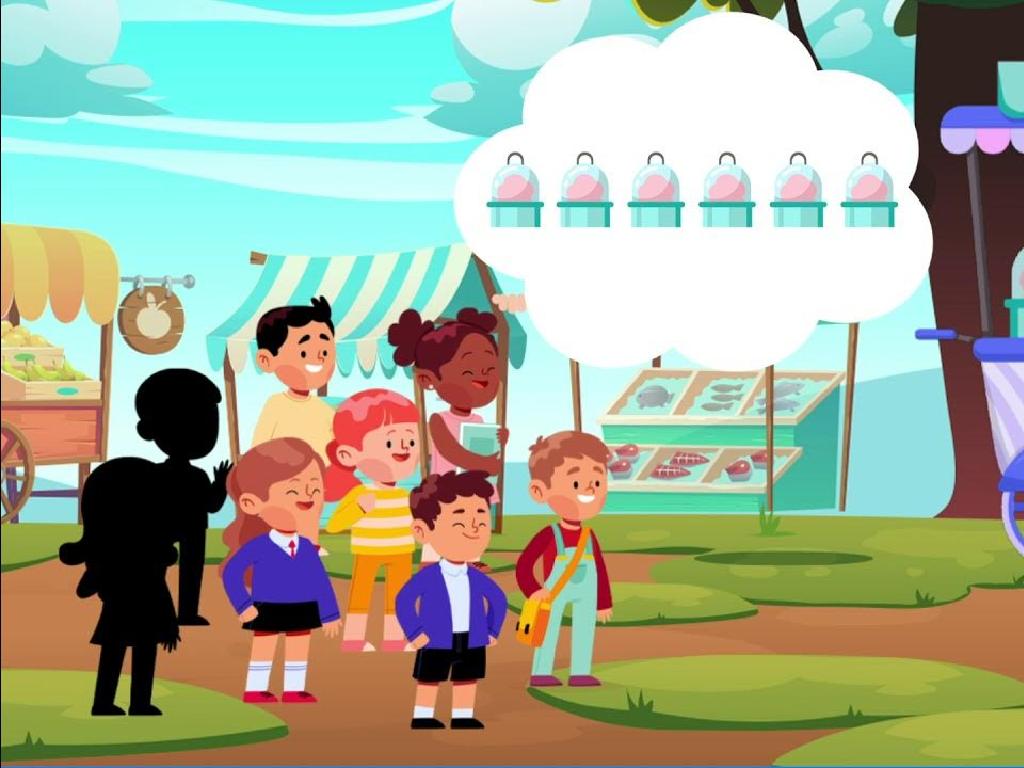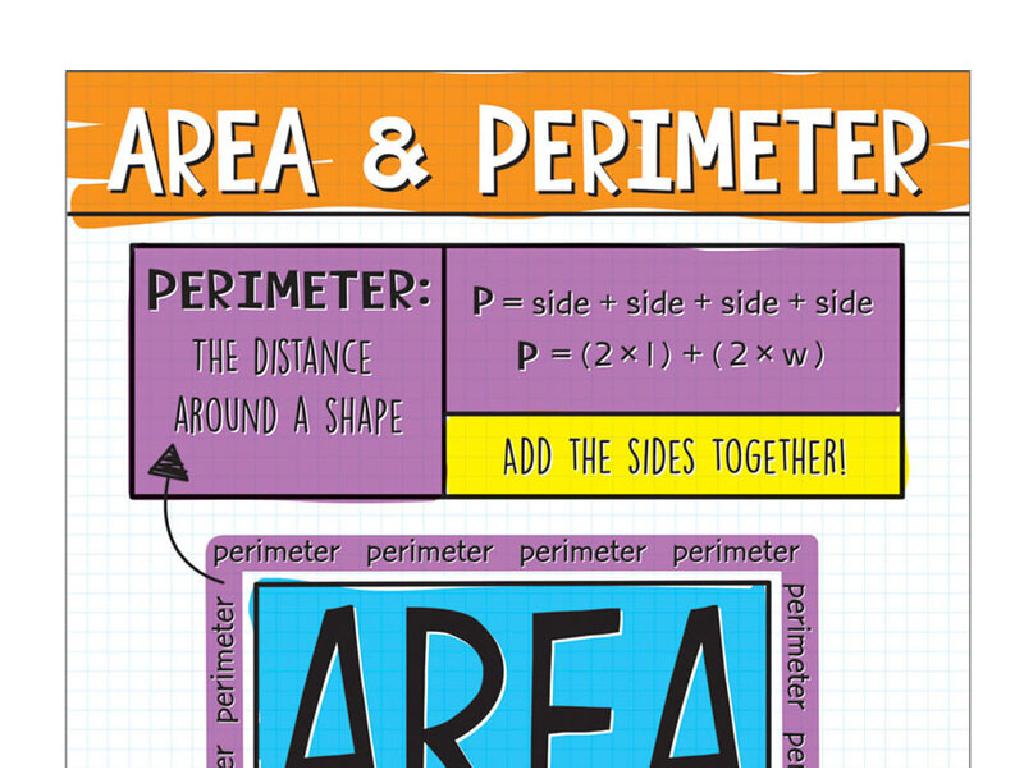Subtraction Sentences Up To 5 - What Does The Cube Train Show?
Subject: Math
Grade: Kindergarten
Topic: Understand Subtraction Up To 5
Please LOG IN to download the presentation. Access is available to registered users only.
View More Content
Welcome to Subtraction!
– Meet the Super Subtractors!
– Learn to take away, up to 5
– If you have 5 blocks and take 2 away, how many do you have?
– Subtraction shows what’s left
– Start with 5 cookies, eat 1, count the remaining
– Practice with cube trains
– Use blocks to show subtraction; remove some and count
|
This slide introduces the concept of subtraction to Kindergarten students in a fun and engaging way. Emphasize that subtraction is simply ‘taking away’ and helps us figure out the number of items left. Use tangible examples like blocks or cookies to illustrate this point. Encourage the children to visualize the process with cube trains, where they can physically remove cubes to see the result. Prepare to demonstrate subtraction with real objects and ensure to have enough cube trains for hands-on practice. Offer guidance as they attempt to subtract and reinforce the concept by asking them to explain what they did in their own words.
Learning Subtraction: Taking Away
– Subtraction means taking away
– Find out how many are left
– If you have 4 apples and give 1 away, how many do you have now?
– Subtraction in everyday life
– Like eating some of your cookies and counting what’s left
– Practice with cube trains
– Use blocks to show 5-2 and see 3 blocks remain
|
This slide introduces the concept of subtraction to Kindergarten students by relating it to simple everyday activities. Start by explaining that subtraction is just taking away some things from a larger group and then finding out how many are left. Use tangible examples like cookies or apples, which are familiar to the children. Demonstrate subtraction using a cube train or blocks, which provides a visual and hands-on way to understand the concept. For example, show a train of 5 cubes, remove 2, and count the remaining cubes together. Encourage the children to participate and practice with their own cube trains to solidify their understanding.
Learning Subtraction: Cube Trains
– Subtraction sentences use a minus sign
– Example: 5 – 2 equals 3
– If we start with 5 cubes and remove 2, we’re left with 3 cubes
– Taking away cubes from a train
– Imagine a train of 5 cubes, remove 2 and count what’s left
– How many cubes are left?
– Practice with different numbers up to 5 and see the results
|
This slide introduces the concept of subtraction to Kindergarten students using the analogy of a cube train. Start by explaining that a subtraction sentence is a way to show taking away using numbers and a minus sign. Use physical cubes to demonstrate the subtraction sentence 5 – 2 = 3, showing that if you start with a train of 5 cubes and take 2 away, you have 3 cubes left. Encourage the students to create their own cube trains with different numbers up to 5 and practice subtracting to see how many cubes remain. This hands-on activity will help them visualize the subtraction process and understand the concept of ‘taking away’.
Let’s Build a Cube Train!
– Cube trains show subtraction
– Build a train with cubes
– Start with up to 5 cubes in a line
– Take some cubes away
– Remove 1 or 2 cubes from the train
– Count the remaining cubes
– How many cubes are left?
|
This slide introduces the concept of subtraction to Kindergarten students using a hands-on activity with cube trains. Begin by explaining that subtraction means taking away. Show them how to build a small train using up to 5 cubes. Then, demonstrate taking away 1 or 2 cubes and ask the students to count the remaining cubes. This visual and physical representation helps them understand the concept of subtraction. For the activity, provide different scenarios where students build their cube trains and then take away a certain number of cubes to solve subtraction problems. Encourage them to say the subtraction sentence out loud, for example, ‘5 cubes minus 2 cubes equals 3 cubes’. This will help reinforce their understanding of subtraction sentences.
Subtracting with Cube Trains
– Start with a 5-cube train
– Remove 2 cubes from the train
– Taking away cubes helps us subtract
– How many cubes are left?
– This is subtraction: 5 cubes – 2 cubes
– Count the cubes to find out
– Counting what’s left gives us the answer
|
This slide introduces the concept of subtraction using a hands-on activity with cube trains. Start by guiding the students to make a train of 5 cubes. Then, ask them to remove 2 cubes and observe what happens. This visual and physical representation helps them understand subtraction as ‘taking away.’ After removing the cubes, prompt the students to count the remaining cubes to find the answer, reinforcing the subtraction result. This activity not only teaches subtraction up to 5 but also enhances counting skills. Encourage students to repeat the activity with different numbers of cubes taken away to solidify their understanding.
Practice Time: Build Your Cube Train!
– Build your own cube train
– Subtract cubes from the train
– Take away one cube, how many are left?
– Create a subtraction sentence
– Example: 5 cubes – 1 cube = 4 cubes
– Share with the class
|
This slide is designed for a hands-on activity where students will apply their understanding of subtraction by physically manipulating objects. Provide each student with a set of cubes (up to 5) to build their train. Guide them to remove one or more cubes and observe what happens. Encourage them to form a subtraction sentence based on the number of cubes they took away and the remaining cubes. For example, if a student starts with 5 cubes and removes 1, they should say ‘5 minus 1 equals 4’. Afterward, have each student share their sentence with the class to reinforce their learning and build confidence. Possible variations of the activity could include subtracting different numbers of cubes or starting with different numbers of cubes in their train.
Class Activity: Cube Train Subtraction
– Build cube trains together
– Teacher says cubes to subtract
– Count cubes left after subtraction
– How many cubes remain after we take some away?
– Practice subtraction sentences
– For example, ‘5 cubes minus 2 cubes equals 3 cubes’
|
This interactive activity is designed to help Kindergarten students understand the concept of subtraction by using a hands-on approach. Each student, or a group of students, will build a train made of cubes. The teacher will then instruct the students to remove a certain number of cubes from their trains. After subtracting the cubes, students will count the remaining cubes and form subtraction sentences based on the activity. For example, if a student starts with a train of 5 cubes and removes 2, they would say ‘5 minus 2 equals 3.’ Prepare to assist students who may struggle with the concept and have additional cube trains ready for practice. Offer praise and encouragement as students grasp the concept of subtraction. Have a variety of activities planned for different skill levels, such as subtracting one cube, two cubes, and so on, up to five cubes.
Super Subtractors: Conclusion
– Celebrating our subtraction skills
– Making subtraction sentences with cubes
– We used cube trains to take away and count.
– Subtraction shows us what’s left
– If we start with 5 cubes and take 2 away, we have 3 left.
– Keep practicing at home!
– Try using toys or snacks to subtract.
|
This slide wraps up the lesson on subtraction sentences up to 5 using cube trains. Congratulate the students on becoming ‘Super Subtractors’ and remind them of the key concept that subtraction is a way to find out how many items are left after some are taken away. Reinforce the idea that they can use physical objects like cube trains to visualize and solve subtraction problems. Encourage them to continue practicing at home with everyday items, which will help solidify their understanding of the concept. Prepare to answer any final questions and give them positive feedback for their efforts throughout the lesson.






